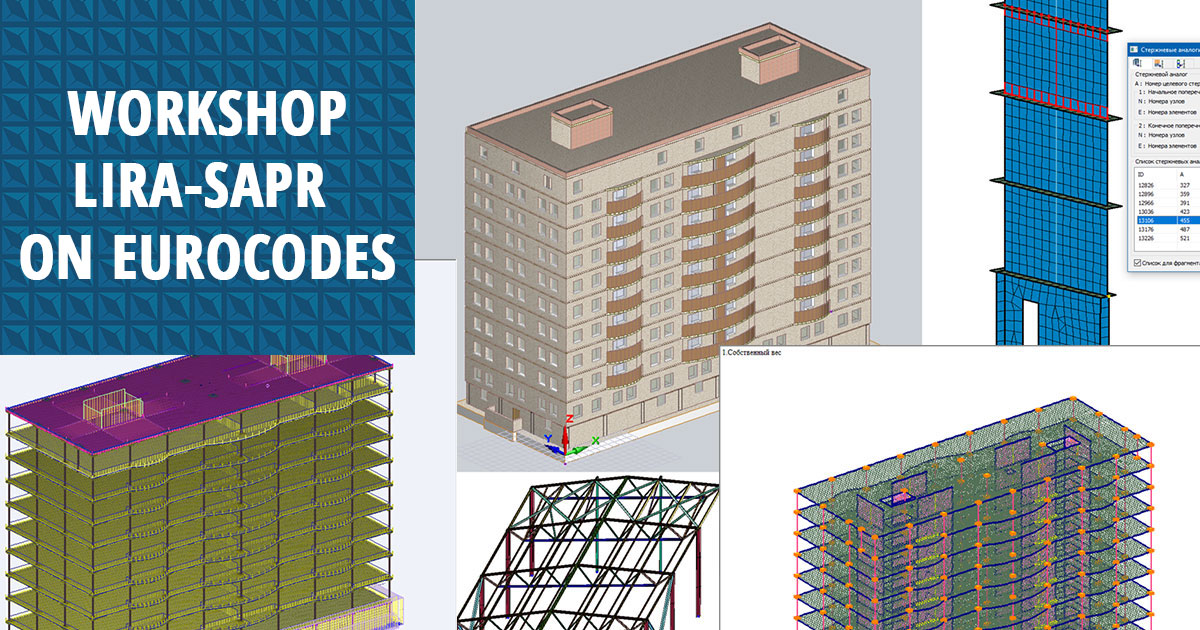Workshop: LIRA-FEM on Eurocodes
The training course is devoted to the calculation of load-bearing building structures in the LIRA-FEM according to the norms of the Republic of Kazakhstan based on Eurocodes (SP RK EN (set of rules of the Republic of Kazakhstan), and National annexes to them and NTP (Normative technical manual)).

February 17, 2023
WORKSHOP: ANALYSIS OF BEARING BUILDING STRUCTURES (SP RK EN, NATIONAL ANNEXES TO THEM, AND NTP)
The course of study from 27 March up to 07 April 2023The purpose of the workshop is to master a single line of design based on the software LIRA-SAPR: setting a building model in the Sapfire preprocessor, obtaining a design model in Visor by entering the missing data for the calculation, using the Soil system to calculate the foundation stiffness, performing structural calculations. The workshop will consider variants of reinforced concrete and steel frames with the analysis of static exploitation and special seismic effects.
Course instructors
Generation of the model in Sapfir preprocessor ' Alexey Melnikov and Alexey Kamanin;
Reinforced concrete frame scheme in Visor, assignment of boundary conditions ' Roman Vodopyanov and Viktor Gubchenko;
Analysis of the results and selection/check of reinforcement ' Viktor Gubchenko;
Steel frame analysis ' Alexey Melnikov.
Acceptance of applications for training
LLP "Allbau Stroysoft", Nikolai Chernushenko, +7 (701) 724-37-52, +7 (707) 676-70-25, info@stroysoft.kz
LLP "BITCOM Software", Anna Usyk, +7 (777) 253 1385, +7 (777) 171 00 31, ausik@bitcom.kz
The language of course: Russian
Detailing program
Workshop program
Part 1. Reinforced concrete (RC) frame analysis.
Generation of RC frame model of RC in Sapfir:
-
creation variants: from scratch using nodes, importing flat substrates using nodes, importing IFC nodes;
- automating the assignment of stiffness characteristics and material parameters in nodes for structural calculations (comparison log), creation of Absolute rigid body, punching contours, etc.;
- rod analogs generation for diaphragms, pylons, and bridges;
- link to the Soil model;
- assignment of loads, automated collection of wind and snow loads;
- setting parameters for calculating seismic impact and mass collection;
- generation of Design load combinations;
- creation of the design scheme (triangulation, control of the design scheme);
- an example of making changes to the design model (substrates/ifc) ' updating the physical and design model.
Working with the design scheme in Visor (FEM-editor in LIRA-SAPR):
- base modeling for static loads (variants of the pile and natural foundation);
- modeling of boundary conditions for seismic action;
- analysis of calculation results;
- analysis of the need to take into account the effects of the 2nd kind for the seismic design combination;
- selection of reinforcement in structural elements by the design situations formed in Design load combinations (ULS and SLS);
- calculation for punching by the design situations formed in Design load combinations (ULS);
- selection of reinforcement and check of the bearing capacity of a plastic wall (diaphragm that perceives seismic loads).
Part 2. Steel industrial frame analysis:
- generation of a steel frame model in Sapfir;
- setting of boundary conditions for load-bearing elements;
- assignment of material parameters for structural calculations in STC;
- assignment of loads, automated collection of wind and snow loads;
- conversion/collection of areal loads on bar elements using Sapfir;
- creation of the first part of Design load combinations in Sapfir;
- creation of a design scheme (triangulation, control of the calculation scheme, transfer to Visor);
- the first calculation to determine the results in the elements of the design scheme;
- assignment of imperfections (transverse loads from longitudinal forces);
- expansion of Design load combinations taking into account specified imperfections;
- creation of non-linear load histories (geometrical non-linearity) for analysis according to the deformed scheme;
- check of steel sections in STC.


Comments